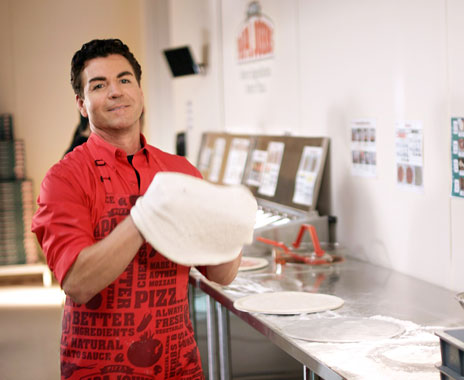Papa John’s latest stop on its “clean label journey” began with some good, old fashioned advertising. As the brand sorted through logistics for its first organic produce pilot, Sean Muldoon, the pizza chain’s chief ingredients officer, watched as a Green BEAN truck drove by. “I picked up the phone one day and just called him,” Muldoon says.
Papa John’s, for quite some time, was interested in taking an organic step forward. But given that the brand has around 3,500 locations throughout all 50 states, this decision was going to take a lot more than good intentions.
In stepped Matt Ewer. For more than 20 years, Ewer has been buying and selling produce. Currently, he owns Green BEAN Delivery, a vertically integrated distribution center that focuses on creating and developing sustainable food systems. The company networks the best local farmers and package those goods for home delivery. It also distributes wholesale to restaurants and retail groups. One more thing: it farms around 120 acres of its own.
A nerve center for Green BEAN is the Louisville, Kentucky, area, which happens to be the home of Papa John’s headquarters. Thus, a partnership was formed.
The immediate result is that Papa John’s organics pilot is ready to roll out in 29 stores throughout the Lexington, Kentucky, market. Roma tomatoes, green peppers, yellow onions, and mushrooms will now be organic toppings straight from family farms. Papa John’s, with Green BEAN’s help, is linking up with operations in Arizona, Florida, Pennsylvania, Kentucky, Oregon, Indiana, and California.
“We at Papa John’s just didn’t have the network of farmers that you would need to go and try to source from during all these different cycles during the year,” Muldoon says. “And that’s where Matt has been great to work with. He does have that network. He does know those farmers. Some of them are his close personal friends. Our team has been out visiting a lot of these farms throughout the U.S. that are going to be supporting our pilot program.”
How Papa John’s is getting there is one thing. The methodology behind the move is another.
Muldoon says the company studied consumer trends and saw that around 13 percent of all the produce grown in the U.S. comes from certified organic farms. Papa John’s believes that metric will only climb in the future, perhaps even to 20 percent by 2020.
“There’s definitely something there,” he says. “In fact, about half of all U.S. households have some sort of organic product or organic produce that they’ve bought from the grocery store, because you see a lot more organics in retail than you do in foodservice right now. But from a foodservice perspective and from a pizza perspective, because consumers are leading us in this direction, more and more increasingly want to know what’s in their ingredients, where they come from, how they’re produced.”
Simply, it’s not something quick-service players the size of Papa John’s typically embrace. That fact is one reason Green BEAN hopped on board so willingly.
“There are just not a lot of people within the foodservice industry beside farm-to-table restaurants that are going down that pipeline,” Ewer says. “And so we looked at this as just a tremendous opportunity to encourage larger players within the foodservice industry to support certified organic farmers, to support sustainable forms of production for agriculture. It was just a great opportunity and a great fit. It’s been a great partnership so far.”
The organics pilot isn’t the only news Papa John’s had in regards to its menu. The brand also announced that it was unveiling gluten-free crust in select markets in Los Angeles, Phoenix, St. Louis, and Nashville. The crust is made with ancient grains, specifically sorghum, teff, amaranth, and quinoa.
Muldoon admits Papa John’s isn’t the first pizza brand to step onto the gluten-free dance floor. However, there is a reason for the late arrival.
For nearly two years, Papa John’s has looked for a gluten-free partner and recipe that meets its standards. There’s been one taste test after another. Panels. Sensory conversations.
“It has to taste good to the point where people at a whole slice of pizza or multiple slices of pizza. A lot of gluten-free products we didn’t see that,” he says. “Some folks have it on their menu but it feels like it’s just checking a box to say they’ve got it. We actually wanted it to be something people crave. That tastes good and they actually want to eat and get excited about the pizza. That was the threshold we had.”
In October, Papa John’s completed the removal of 14 ingredients from its menu as part of its clean label initiative, a process that costs the brand around $100 million or more each year.
Gone were artificial colors and flavors, preservatives, sweeteners, and flavor enhancers from all its products. The company also recently transitioned the chicken it uses to be fed on a vegetarian diet and raised without antibiotics, and its eggs to be cage free.
“We are pretty proud of some of the milestones that we’ve been able to reach,” Muldoon says.










